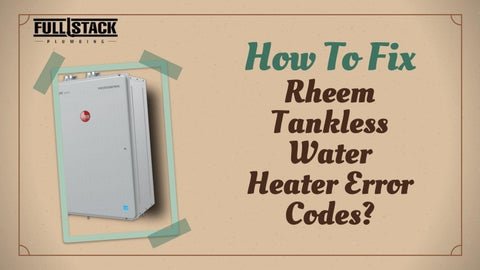
In simple terms, the “Le” error code on a Rheem water heater usually indicates a leakage error. Imagine a leak in your garden hose; over time, it causes water to escape, leading to a loss in water pressure and potential damage to nearby areas. Similarly, the “Le” code suggests a possible leak within the unit or in the connections, signaling you to take action before it turns into a big, soggy mess. Ignoring it could be akin to ignoring a slow tire leak in your car — eventually, it’ll leave you stranded.
Understanding the “Le” Error Code
So, what’s the exact message behind this cryptic “Le” code? Well, when your Rheem water heater shows this signal, it’s like your heater sending out an SOS. In this case, “Le” stands for a leakage detection. Just like a smoke detector blaring when there’s smoke, your water heater is alerting you of a potential leak, whether it’s in the tank, pipes, or valves. This detection is a built-in feature designed to prevent water damage and waste, which can be akin to your house’s safety net.
Now, you might be thinking, “Can’t I just let it be for a while?” The short answer is no. Ignoring a leak can lead to more than just a wet floor. Over time, small leaks can cause significant water damage to flooring, walls, and even the foundation of your home. Additionally, if water consistently escapes, your heater will work overtime to heat more water, leading to higher energy bills — and nobody wants that, right?
Here’s the good part: understanding what causes the “Le” error can help you address it more effectively. It might be due to a faulty valve, loose connection, or even corrosion in the tank. Think of it as unraveling a mystery; once you pinpoint the cause, you can tackle it head-on.
Consequences of Ignoring the Error Code
You might wonder, “What’s the worst that could happen if I just ignore this for a while?” Well, let’s dive into that. Ignoring the “Le” error code isn’t just about a few drips here and there. Sure, in the short term, you might avoid the hassle of repairs, but it could turn into a costly affair later on. Picture a small crack in your windshield — leave it unattended, and it spreads until you need a full windshield replacement.
Similarly, continued leakage can lead to structural damage. Water damage is sneaky; it creeps up slowly, often going unnoticed until it’s too late. From warped floors to peeling paint and damp, mold-infested walls, the repercussions are both extensive and expensive. Plus, water-damaged areas can become breeding grounds for mold and mildew, potentially causing health issues down the road.
Moreover, there’s the efficiency aspect. A water heater with a leak has to work harder to maintain the heat, meaning more energy consumption. This not only inflates your utility bills but also reduces the lifespan of your heater. It’s like driving a car with a leaky gas tank — you’re losing fuel unnecessarily.
Taking Action: What to Do Next
So, you’ve acknowledged the “Le” error — great first step! Now, what? You don’t need to be a plumbing expert to tackle this problem, but a little diligence goes a long way. First, turn off the water supply to prevent more water from leaking. It’s like putting a tourniquet on a bleeding wound — it stops the problem from getting worse while you figure out the next steps.
Next, inspect the surrounding area for any obvious signs of leaks. Check the valves, pipes, and the base of the heater for any signs of water. If you spot something, it might be a simple fix, like tightening a loose valve or replacing a worn-out gasket.
If you’re unsure about your findings or the issue seems significant, it’s wise to call a professional. Think of it as going to a doctor when you have a persistent cough — sometimes it takes a trained eye to diagnose and resolve an issue. A certified technician can ensure repairs are done correctly, preventing future mishaps.
Preventing Future Error Codes
Once you’ve resolved the current issue, the next logical step is preventing it from happening again. Prevention, as they say, is better than cure. Regular maintenance is key. Schedule annual inspections with a plumbing professional to ensure everything is in tip-top shape. It’s like going for regular check-ups to keep your health in check.
It’s also a good idea to keep the area around your water heater dry and free from clutter. This not only prevents accidental damage but also makes it easier to spot any potential leaks early. Think of it as keeping your desk tidy — it helps you notice when something is out of place.
Lastly, consider installing a leak detector. These handy devices can alert you to the presence of water in places it shouldn’t be, essentially acting as an early warning system. Just like a car alarm deters theft, a leak detector can save you from costly water damage.
In summary, while it’s tempting to ignore that pesky “Le” error code, doing so can lead to a cascade of issues down the road. With prompt action and preventive measures, you can ensure your Rheem water heater continues to serve you efficiently, keeping those refreshing hot showers coming.